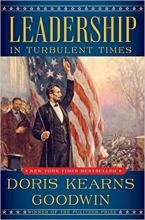1) What is your suggestion about?
This book gives hope.
Doris Kearns Goodwin provides in Leadership in Turbulent Times a glimpse behind the curtain into the lives and leadership experiences of four US Presidents: Abraham Lincoln, Theodore Roosevelt, Franklin D. Roosevelt, and Lyndon B. Johnson.
The book explores theses president’s tragedies as well as triumphs. She brings to life how each leader kept a keen focus on achieving the greatest good by never abandoning their values, ideas, and visions. They did so even though they all faced intrapersonal and interpersonal adversity, often felt abandoned and alone in their efforts, and were not always popular among those they served. In doing so, Kearns Goodwin gives hope that we too can overcome the challenges of the 21st century.
2) Why did you choose it?
Doris Kearns Goodwin builds upon her lifetime of research into the lives of these presidents to communicate how our heroes are also real humans – humans who faced personal challenges like we all face.
The book is easy to read and understand. Each president is introduced with a brief biography along with an overview of their leadership styles. The author provides a list of practical lessons for readers to incorporate into their lives. The book is also divided into sections. That way the stories of the four presidents show both similarities in character, experience, and personality as well as differences between their times and challenges.
I really enjoyed the blend of history with practical lessons in leadership. The book does a great job showing how each president adapted their unique skills and styles to their times, overcame challenges, and seized opportunities to make the country better.
3) What else do you want to tell us about it?
Here are some highlights of what I took away from the book as I reflected upon my own professional development and how to help colleagues and serve our fellow citizens:
- Find ways to cope with pressure, maintain balance, and replenish energy. Lincoln, when under duress, found ways to create an outlet for himself – often spending time with family, reading, or attending theater.
- Know when to hold back and when to move forward. Lincoln was exquisite in this arena – although he suffered from mental turmoil, doubt, and stress in the face of big decisions, he would find the right time, make his decision, and then remain steadfast. Consider, for example, the Emancipation Proclamation.
- Consider options; be ready to adapt as a situation escalates. Theodore Roosevelt routinely would consider multiple strategies and analyze them before choosing his path forward. Nonetheless, Roosevelt remained open to the possibility that new information may change his assessment. So Roosevelt remained flexible and adaptive, open to the views of others, and yet also trusting of his instincts.
- Pause to open the window of time. FDR often cited the need to “provide an anesthetic before the major operation.” He meant that before making any major decision or announcement, he would pause and reflect. According to FDR, this allowed for all pieces to be fully in place, and people ready to leave behind one way of doing things for a new, better way.
- Master the narrative. LBJ was a master storyteller. LBJ could link together his ideas into a story that resonated with his team, other leaders, and citizens. For instance, LBJ would often personalize complex issues and give them the names and faces of real people to illustrate the realities of tasks at hand.
You can also see Doris Kearns Goodwin sharing some of her highlights from Leadership in Turbulent Times in this interview.
She is one of the leading historians of our time. I encourage you to also read her biographies, especially her Team of Rivals: The Political Genius of Abraham Lincoln (2005) that provided the basis for the Steven Spielberg’s Academy Award winning film “Lincoln” (2012).
4) What is the key takeaway for leadership driving improvement in how we deliver for the citizens of Missouri?
Doris Kearns Goodwin shows through her histories we all face similar challenges in leading others, articulating a vision, and striving for excellence. We can therefore learn from our great presidents.
Their experiences help us define what type of leader we might want to be. They also highlight that serving our fellow citizens involves working hard every day to achieve collective excellence.
We can learn a lot from those who served before us. Our work is critical. We can make a difference in people’s lives.



Comments